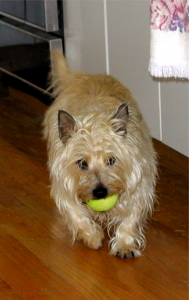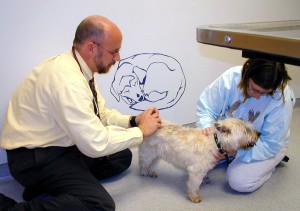< updated 22APR18 >
This article is part of a larger article, Trends in Training – The Evolution of a Pet Care Professional, which describes my development as a professional dog trainer and our involvement with holistic veterinary medicine. You can find the entire article at: http://blog.greenacreskennel.com/2008/04/19/professional-development-trends-in-training-the-evolution-of-a-pet-care-professional/
 In April of 2000, our Golden retriever Tikken went to her veterinarian for her annual examination and received a two-year rabies booster. At the time, Maine law required a rabies vaccination every two years even though the vaccine was labeled as effective for three years.
In April of 2000, our Golden retriever Tikken went to her veterinarian for her annual examination and received a two-year rabies booster. At the time, Maine law required a rabies vaccination every two years even though the vaccine was labeled as effective for three years.
It was in July of 2000, when my sweet, cuddly Golden Retriever suddenly, and without warning or provocation, transformed from Tikken to Cujo, just like Dr. Jekyll turned into Mr. Hyde. One moment all of our dogs were lying calmly on the floor as my wife Paula watched television. Suddenly Tikken just exploded and within seconds she had ravaged Crystal, our Pekinese, causing the loss of Crystal’s left eye.
While we had seen a few small signs of “irritability” in Tikken over the past couple of months, the apparently unprovoked nature of this attack, and its severity, led us straight to our veterinarian for a thorough check-up, including a complete thyroid panel and behavioral assessment. Her thyroid was abnormal, but not in a manner which suggested the need for medical treatment. However, based on the advice of the veterinarian, we started Tikken on a course of Clomipramine. We also began a strict management protocol with the dogs. Unless we were present Tikken was separated from all but one of our older dogs, Shed. Tikken and Shed had bonded closely when Tikken was a puppy, she was always very respectful of Shed, and they were similar in size.
We noticed increasingly anxious behaviors by Tikken. Now she became overly excited at mealtime, and became enraptured by any shadows or moving lights. These behaviors became so obsessive that I could not even distract her with fresh meat when she got caught up in a shadow or flickering light.
Seeing no improvement in Tikken’s behavior, our veterinarian recommended a consultation with Dr. Dodman at the behavioral clinic at Tufts University. They recommended we put Tikken on a higher dose of Clomipramine, establish and maintain a dominance hierarchy, manage her environment, and institute a Nothing In Life Is Free (NILIF) program. We were already managing and doing NILIF and I had concerns about the validity of the hierarchical approach, so we were really hoping for the Clomipramine to work. What we ended up with was a dog that was so doped up that she seldom moved. She still became excited at mealtime and got caught up with shadows and light. She just moved slower. To us she seemed to have lost her will to do anything but lie around.
We were very concerned about Tikken’s quality of life, and with no changes after

six months of the higher dose of Clomipramine, we contacted Dr. Patricia McConnell, a behaviorist we had previously worked with when we were in Wisconsin, for another opinion. After reviewing Tikken’s history, Trish advised us that she had not had much success with dogs exhibiting Tikken’s issues using behavior modification, drugs or a combination of both. She did however indicate she had heard of some successes when treating with homeopathy. We immediately made an appointment with our homeopathic veterinarian, Dr. Judy Herman at the Animal Wellness Center in Augusta.
Dr. Herman diagnosed Tikken with rabies miasm. A miasm is when the body/mind/emotions of an individual manifest signs of the disease without actually having the disease. Tikken was given a homeopathic remedy at the conclusion of the consultation and within eight weeks she was weaned off Clomipramine entirely. We were soon seeing dramatic improvements in her symptoms. Tikken was treated two other times with the same homeopathic remedy over the next few months. We still managed the dogs closely, but Tikken eventually became reintegrated with the rest of the pets in the household. Homeopathy gave us our sweet, cuddly Golden back.
 Since Dr. Herman felt that Tikken’s issues were the result of a reaction to her rabies vaccine we evaluated our vaccination protocols with all of the dogs. We have been doing titer tests in lieu of vaccinations since that time, with the exception of the rabies vaccine. Tikken did receive two subsequent rabies vaccines under the guidance of Dr. Herman, followed by treatment homeopathically. When she developed a second immune mediated disorder (pigmentary uveitis) in 2004, we decided to stop any further rabies vaccines, and she now has a medical exemption which still allows her to be licensed.
Since Dr. Herman felt that Tikken’s issues were the result of a reaction to her rabies vaccine we evaluated our vaccination protocols with all of the dogs. We have been doing titer tests in lieu of vaccinations since that time, with the exception of the rabies vaccine. Tikken did receive two subsequent rabies vaccines under the guidance of Dr. Herman, followed by treatment homeopathically. When she developed a second immune mediated disorder (pigmentary uveitis) in 2004, we decided to stop any further rabies vaccines, and she now has a medical exemption which still allows her to be licensed.
Paula and I both started to read more about vaccines and become further educated about alternatives. We made the decision to allow our clients to also do titer tests in lieu of vaccines, as long as the tests were done under the direction of a veterinarian.
Paula and I felt so strongly about the vaccine issue that in April of 2002 I wrote

Rethinking Annual Vaccinations for the Green Acres newsletter. In this article I disclosed that as early as 1992 veterinary textbooks were questioning annual vaccinations (Current Veterinary Therapy, volume XI, pp202-206: “A practice that was started many years ago and that lacks scientific validity or verification is annual revaccination. Almost without exception there is no immunological requirement for annual revaccination. Immunity to viruses persists for years in the life of the animal.” – Dr. Ronald Schultz, Veterinary Immunologist. In this article, I suggested that minimally clients talk with their veterinarian and ask if titer tests were an option. Needless to say, several veterinarians in our service area were not too happy with me, but I still believe I did the right thing. I felt somewhat vindicated a year later when the American Animal Hospital Association published their new vaccination guidelines which started a move away from annual vaccination.
|

Recommended Resources
Meet the dogs with OCD by Shayla Love – An article and podcast from June of 2017 discussing ongoing research of OCD. – https://mosaicscience.com/meet-dogs-OCD-canine-compulsive-disorder-people/
©2018, Donald J. Hanson, All Rights Reserved <Click for Copyright and Use Policy>
































